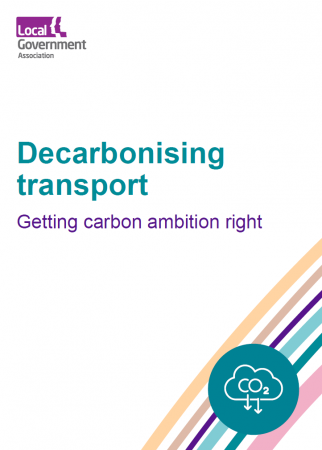ACTIONS
- Protect and safeguard cultural and natural heritage
- Learning and educational opportunities
- Cultural participation/social inclusion
- Sustainable tourism
- Support research
- Employment (recruiting, training, safety)
- Energy consumption, greenhouse gas emissions
- Waste management and reduction
- Transport (forms of, energy use)
- Commercial activities including copyright and IP
- Governance and management
- Security, disaster preparedness, risk reduction
- External partnerships and collaborations
- Toolkit/framework/roadmap
- Case studies
Decarbonising transport: Getting carbon ambition right

Intended Audience
Councils working on greenhouse gas emissions reduction.
- Local Government Association, UK Government
“This briefing note sets out the framework within which councils can begin to deliver ambitious action plans. It explains some of the key issues surrounding carbon targets and budgets, and what levels of emission reductions are necessary to be consistent with the Paris Agreement.” (p.4)
Avaiable in
- English
SDGs LINKAGES
The resource is most closely linked to SDG 11.2 (sustainable transport), which supports a range of further SDG targets including 11.6 (reducing the environmental impact of cities), 11.7 (universal access to safe and welcoming green and public spaces), 12.2 (sustainable use of natural resources), 12.6 (adopt sustainable practices and reporting), 12.7 (sustainable procurement), 13.3 (climate action), 7.2 (adopt renewable energy sources), and 16.B (promote laws and policies for sustainable development). The emphasis on differences in emissions from rural and urban sources, and on improving on these, supports SDG 11.A (promote links between urban, periurban and rural areas for sustainable development). As tourist travel can be a major source of greenhouse gas emissions, action in support of the resource can support SDG 8.9 (sustainable tourism).
Click on the SDG Target to discover Our Collections Matter indicators
-
Our Collections Matter indicators:
- Proportion of energy that comes from renewable sources.
- Date to achieve net zero, and milestones towards that date.
-
Our Collections Matter indicators:
- Numbers of jobs created or supported that relate to sustainable tourism drawing on local products (e.g. craft producers).
- Develop and implement plans to reduce and remove negative impacts of tourism.
- Numbers of activities and/or products drawing on local culture.
- Value to artisans and source communities of activities and products drawing on local culture.
-
Our Collections Matter indicators:
- Plans in place to reduce negative impacts on air quality, and volume and forms of waste.
- Plans in place to eliminate waste of all forms as soon as possible.
-
Our Collections Matter indicators:
- Numbers of people accessing collecting institutions from different demographic groups, notably women, children, older people and persons with disabilities.
- Increases in numbers of people accessing collecting institutions from different demographic groups.
- Measures taken to remove barriers to access green and public spaces.
- Extent of green space provided by collections institutions.
-
Our Collections Matter indicators:
- Considerations of regional economic, social and environmental trends and risks incorporated into collecting institutions’ planning.
- Participation in local and regional planning, to foster access to services, cultural participation, prevent exclusion, and support equitable urbanisation.
- Ensure data collection and metrics can be useful for planning in conjunction with other sectors and between urban and rural areas.
- Number of outreach and other activities that promote awareness and accessibility of collecting institutions in urban and rural areas, and that promote awareness of regional development plans and risks, with opportunities for people and communities to input into such plans.
-
Our Collections Matter indicators:
- Reduction of material footprint in terms of reductions in consumption of biomass, fossil fuels, metal ores and non-metal ores.
-
Our Collections Matter indicators:
- Clear visions, strategies and plans in place for all aspects of sustainability – environmental, social and economic (people, planet, prosperity)- across all areas of activity.
- Visions, strategies and plans relating to sustainability to be publicly available and incorporated into planning documents.
- Commitments to be in line with local, regional, national and/or international targets and ambitions.
- Incorporation of sustainability into reporting for funders and other stakeholders, including the public. Reporting to include commitments and progress towards targets.
-
Our Collections Matter indicators:
- Incorporation of sustainability considerations into procurement, in terms of advertisement and invitation to tender, contracts, and selection criteria for suppliers.
-
Our Collections Matter indicators:
- Plans in place to enhance positive contributions to addressing climate change through use of collections. Plans in place to ensure collections, collections institutions and broader society can adapt effectively to climate change.
- Plans in place for effective education and awareness raising on climate change mitigation, adaptation, impact reduction and early warning.
- Plans in place to reduce negative contributions of collections-related functions, e.g. measuring greenhouse emissions with plans and targets in place to reduce them.
-
Our Collections Matter indicators:
- Proportion of population [audience/users/non-users] reporting having personally felt discriminated against or harassed in the previous 12 months on the basis of a ground of discrimination prohibited under international human rights law.
- Number and proportion of policies that incorporate sustainable development considerations, in the full sense of recognizing all three of social, economic and environmental considerations.
-
Our Collections Matter indicators:
- Plans in place to ensure safe, affordable, accessible and sustainable transport systems for all, in terms of accessing collections-based institutions.
- Plans in place to use collections-based institutions to provide education and awareness of public transport systems and their development.
- Special attention to those in vulnerable situations, including women, children, disabled and older people, taken in plans regarding public tansport.
